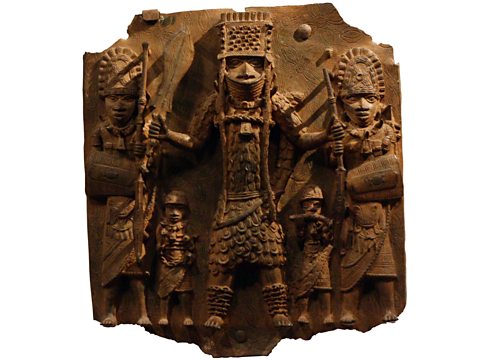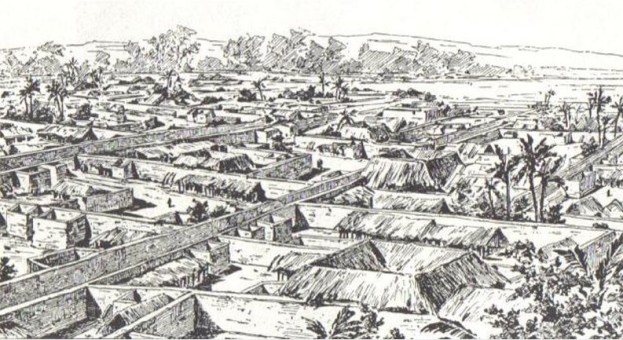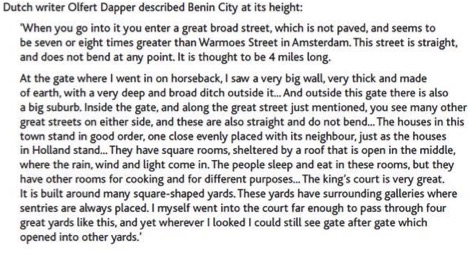
Currently inhabited by the Edo people, a native ethnic group to Nigeria, Benin City was an unofficial wonder of the Ancient world for its exceptional craftsmanship with Ivory, Bronze and mud, its architectural wonders and man made .
With an unknown exact date of origin, Benin City is thought to be established around 1180 by Eweka who ruled until his death in 1246.
The name Benin is one that derives from its Portuguese settlers who began trading with the region in 1485. However, the name had changed several times before their arrival; partly because of the amalgamation of new languages coming into the region.
Originally, the people and the city were named the ‘Edo’, as many prefer to be called today, yet this changed after a period of civil war where Ewuare wrestled power from his brother Uwaifiokun during a coup in 1440.
Later to be known as Ewuare the Great in 1440; soon after his victory and newly appointed title of Obe, or ‘King’, he changed the name of the people informally to the ‘Ubinu’.
Archaeologists argue that this was to distinguish his Empire from that of his overthrown and largely despised brother, Uwaifiokun.
Within five years, Oba Ewuare transformed the region in order to protect himself from any potential coup and rebuild the nation which had largely been destroyed by the war.
He did this by commissioning a then nationwide moat around the city and hundreds of walls which divided the land into separate and distinct areas depending on what trade would be undertaken there.
Whilst the concept itself was not revolutionary, the design was and it ensured that his Kingdom remained secure from the exterior and within throughout his reign, even as Ewuare expanded his kingdom into what is now the greater area of Nigera.

There are 201 orally recorded victories by Ewuare and his Army which took his Kingdom from the Benin River into the Niger Delta and South of the Benin River. A modern equivalency to the Edo Empire would be a kingdom stretching from
Ogun, Osun and Ekiti, south into Ondo State, Edo State and Delta State, Bayelsa, Rivers and Imo with with further, far smaller and sparsely spaced settlements within the states on those boarders. Osun, Ekiti, Kogi, Amabra, Abia, Imo and Akwa Ibom. In fact, the span of the Edo Empire is what many of these states have remain divided into until this day.
With the span of the Empire, Oba Ewuare managed peace by toppling may of the settlements he came across and established leaders who were his allies.
Ewuare also created a number of new positions within Edo society, the ghabho n’ore (town chiefs) and the Eghabho n’ogbe (palace chiefs). These were essentially civil servant positions which handled eveything from Taxes to Law and Civil disputes.
Ewuare also established a clear line of succession to his throne. Before, the duty to ordain the new king fell on the Uzuma, Chiefs who could limit the power of the Oba whilst conducting administrative duties on his behalf. By limiting their power, Ewuare also reduced the threat of an uprising as he personally gave power to those who proved to be his trusted allies.
It was also a move that would serve to preserve his lineage, ideals and practises as the possibility of a different ruling faction taking over was significantly reduced.
Ewuare also strengthened his Empire by largely using foreign investment to fund his city being rebuilt. Composing of both people from the larger area of modern Nigeria, Ewuare also opened his boarders to European and Asian travellers, merchants and settlers to whom the Edo people traded and interacted with.
By establishing a strong economy, line of succession, and security within his boarders, Benin City and the Edo underwent a period of a golden age which saw the region become well known for it’s sculptures; particularly in Ivory and Bronze- many of which are now in British Museums today.
Ewuare also established the practise of scarification; a practise which remains in Nigeria and parts of Africa till this day. Ordered to be carried out on the freeborn population, it was designed to differentiate the classes between freeborn and slave and the Edo citizens from the rest of the world.
The arrival of the Portuguese in 1485 may have occurred after Ewuare’s death in 1472 but his influence lingered, even through the five years which followed his death and two changes of Oba. It was an influence so strong that the Portuguese did not initiate the trade of slaves, based off initial reports between Ruy de Sequeria and Ewuare in 1472.
It would take several decades for Ewuare’s vision of a well fortified Benin City to be complete and he would not see his vision come to life as he died before the work was completed. Now the length of 6214 miles (10,000km), the fortifications around Benin City would be the second longest man-made structure of all time; second only to the Great Wall of China.
Between 1485 and 1500, more Europeans began to trade and explore with the Edo Empire and Benin City in particular. During one visit by Dutch Explorer Olfert Dapper, who visited Benin City soon after the completion of it’s defensive fortifications, he wrote:
“When you go in you enter a great, broad street which is not paved and seems to be seven or eight times (wider) than Warmoes street in Amsterdam. This Street is straight and does not bend at any point. It is thought to be 4miles long.
And the gate where I went in on Horseback, there was a very big wall, very thick and made of earth, with a very deep and broad ditch outside it… and outside this gate there is also a big suburb. Inside the gate and along the great street I just mentioned, you see many other great streets on either side, and these are also straight and do not bend.
The houses in these towns are in good order, one placed evenly closed with it’s neighbour, just as the houses in Holland stand.”

Sadly, the grandeur and much of the History Benin City held for the Edo Region was lost when the British invaded, burned and eventually annexed the region in 1897 after an expeditionary force was killed, leaving only two survivors.
The invasion was justified after a report by the British expeditionary force claimed that human sacrifice was part of Benin state’s culture. These claims are heavily criticised as simply fictitious for the claims originate a year after original expeditionary force was in Benin and no other accounts; written or oral make note of human sacrifice.
Today, Benin City remains 40 kilometres north of the Benin River, a fraction of the size it once was, yet still a cultural powerhouse in Nigeria; largely due to the influence of Oba Ewuare, eleventh Oba of Benin and the first Oba of the Benin Empire.
